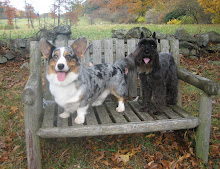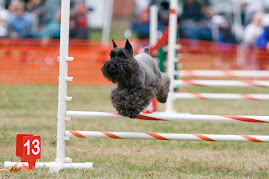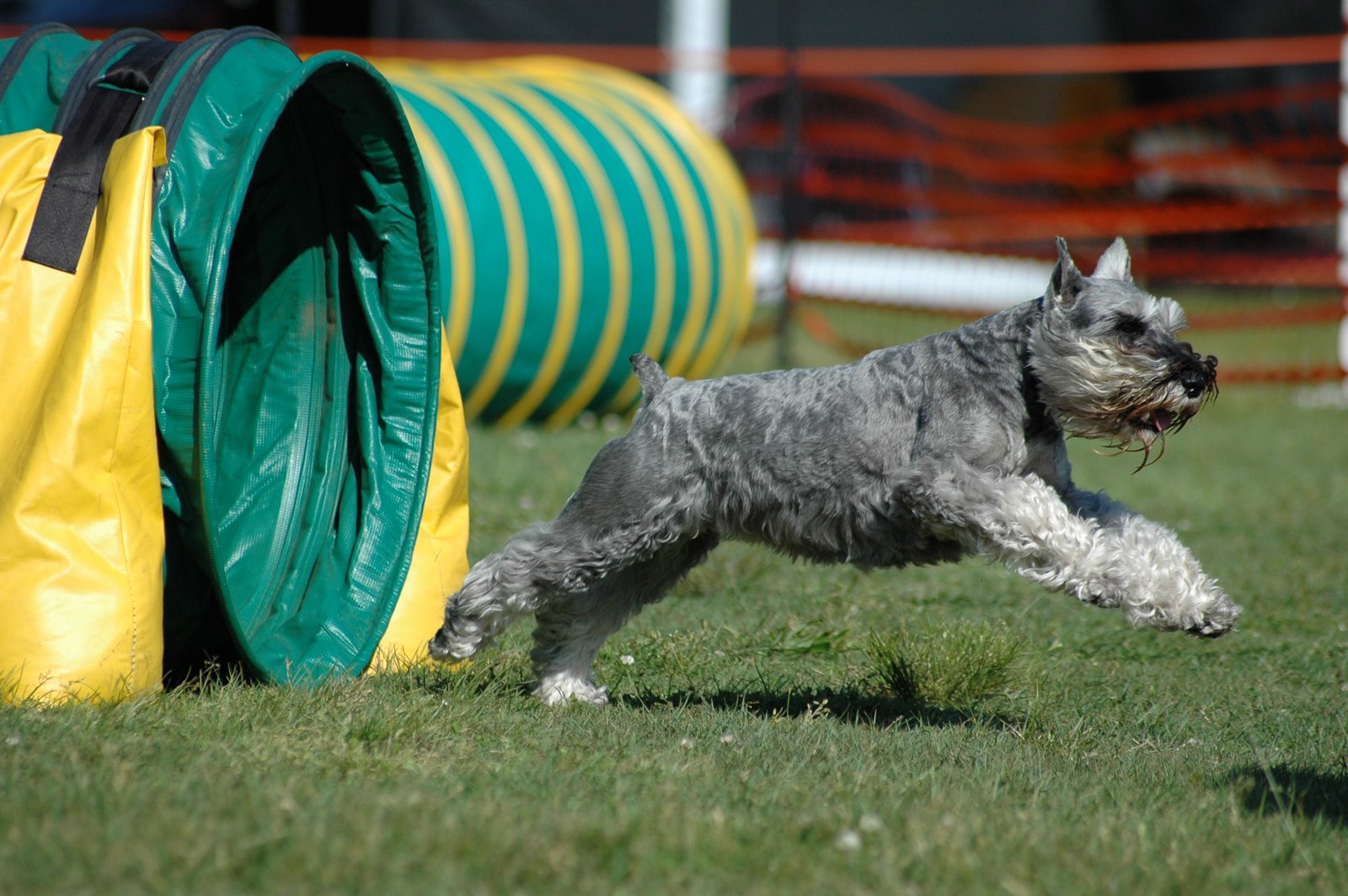My primary reason for wanting to attend this seminar is my nearly 3 yo CWC Bug. Bug has one hip that is mildly dysplastic. He does not *display* and two separate vets have said they do not think it will inhibit him from doing performance sports as long as he is not a weekend warrior (i.e. properly conditioned) and kept lean. However, in my paranoia - I want to do everything I possibly can to make sure he is in the best position to lead a pain free life and play hard (or as hard as he wants to).
The first couple of hours of the seminar focused on structure and DGS made a very thought-provoking (and obvious) statement.
Our choice of sport for our dog is often arbitrary. We frequently do not take their structure into account in the sports we choose for them. To make her point she went around the training center and told various people what their job was going to be. I was going to play for the Bruins. Ha!
In terms of choosing a puppy. She said 8 weeks is when the structure will most closely resemble what you will eventually end up with. The pup that cannot sit still is NOT the performance pick – they are a dog that is not comfortable in their own body.
She talked about how structure can effect a dog’s performance and physical well being over time – i.e. if you ask a dog with poor shoulder layback to jump repetitively you are eventually going to see back problems. She suggested the best thing you can do is understand your dog’s physical weaknesses and plan for them.
This portion of the seminar gave me a MUCH clearer idea of the role structure plays in asking our dog to do performance sports. It also helped me see what is considered more ideal in terms of structure and problems that can arise due to poor structure.
There was a dog attending the seminar who has slipped hocks. Slipped hocks are a condition in which the tendons holding the hocks are extremely lax (basically the hocks are the equivalent of double-jointed). There is absolutely nothing you can do about it. DGS had her handler put her up on the table and showed us what slipped hocks look like. It was amazing - DGS put pressure on her hocks and they popped forward like a rubber band.
The second portion of the seminar focused on Get On The Ball. When I saw DGS in November she suggested this would be helpful for Bug. I bought an Pezzi EGG ball from her and borrowed a friend's DVD of Get on The Ball. I watched the DVD and found it to be VERY straight forward. However, I knew DGS was going to be doing a seminar for Act-Up and wanted to actually work through my introduction to GOTB with her.
What can I say, it was amazing. Not a single dog, even my wary-of-novel-stimuli CWC had any problems with the ball. Bug was not willing to jump up on the ball at the seminar (although he offered it at home that very same night), but he was comfortable enough to place his front feet on the ball and allow me to pick him up onto it. DGS suggests 5 - 10 minutes every day for two weeks before you will see a strength change or you begin adding any tricks (give paw, sit pretty) or extending the time spent on the Ball.
Initially you ask your dog to look left, look right, look up, look down all while they are standing on the ball (this is all done with plenty of treats) and you are GENTLY bouncing the ball. They can also be sitting, but due to the fact that standing is actually physically harder for them, reinforce standing highly if they offer it. She suggested NOT doing GOTB the day prior to class or a trial.
Even with my hairy dog I could feel his muscles working. For a dog that is dysplastic or has weak hips, DGS recommends that once they are comfortable on the ball you have the dog get into frog position on the ball - place your hand on the pelvis and bounce gently. She said this causes the inside hip muscle to flex which is very useful for dogs that have hip issues. This exercise should be done every other day, not on a daily basis. In terms of obedience, she said that asking a dog to sit on the ball will help with sloppy sits as it also causes the inside hip muscle to flex.
As an example she mentioned her 13 yo Lab who has HD. She has force-pressure plates in a portion of the floor of her facility so that she can see how much pressure a dog exerts on each limb. She said after a GOTB session her dysplastic Lab exerts 12% more pressure with his rear legs. This is pretty cool.
One thing that DGS stressed is that you really do want to spend the extra money on the Pezzi Egg ball. The reason is that the pilates balls you can purchase at Marshalls, Target or Wal-Mart are too small for most dogs to stand naturally on them. This causes their body to contort and work in an unnatural manner. She said they are probably fine for a Papillion or Chihuahua, but for anything larger a Pezzi Egg is recommended. She has also never heard of a Pezzi Egg breaking due to use.
After lunch we had a session on stretching. Debbie gave us a minimal stretching routine in the hopes that we might actually do it! Her suggestion is to plan for 15 - 20 minutes prior to a run.
- 5 minute walk - to allow dog to loosen up and empty the bladder, etc.
- 5 minutes of a fast walk interspersed with a slow jog
- Stretching
The simple stretches she recommended become the cornerstone of our stretching routine are:
- Front - Extend the shoulder slowly straight forward (think high-5). Hold this for 15 seconds. Switch sides. Do this three times on each side.
- Rear - Extend hip straight back (using two hands - one near the knee and the other higher up near what would be the inner thigh). Hold this for 15 seconds. Switch sides. Do this three times on each side.
For dogs with hip issues add the "fire hydrant." In this stretch you lift the hip/leg up like a male dog marking. Hold this for 15 seconds. Switch sides. Do this three times on each side.
Her next suggestion was "dancing" - have your dog walk backwards on their hind legs. For long backed dogs she recommended having them back-up. Her personal cue is "beep, beep," which I love!
For cool down:
- 5 minutes fast walk/jog
- 5 minute walk
- Same stretches mentioned above but hold them for 20-25 seconds.
She said obviously this is not always going to be possible but it is in our dog's best interest not to be shoved into a crate after a physical activity like running a course.
The next portion of the seminar was on Strengthening.
Tugging came up and DGS agreed it is excellent for building rear strength it must be done properly. NEVER tug higher than your dog's head as this can cause cervical soreness. Do not allow your dog to tug on their leash and be dragged along - this can also cause cervical soreness.
DGS feels every dog should do cross-training and every dog should have a break. As an example she pointed out that professional athletes have an off-season.
For strengthening DGS recommends plyometrics.
From Wikipedia:
Plyometrics is a type of exercise training designed to produce fast, powerful movements, and improve the functions of the nervous system, generally for the purpose of improving performance in a specific sport. Plyometric movements, in which a muscle is loaded and then contracted in rapid sequence, use the strength, elasticity and innervation of muscle and as it was supposed to be surrounding tissues to jump higher, run faster, throw farther, or hit harder, depending on the desired training goal. Plyometrics is used to increase the speed or force of muscular contractions, often with the goal of increasing the height of a jump or the speed of a punch or throw.
DGS suggested setting up 5 jumps at half-height with the dog's length (nose to tail) times two between each jump. Do this 5 times in a row, three times a week.
For power walking or hiking to build endurance DGS suggested a minimum of 30 minutes.
The flying dog is a favorite exercise of hers, too. You pick up a hind leg and the opposite front leg - just a few inches off the ground. Hold for a couple of minutes and alternate.
By the time the Strengthening session started both Bug and I were beat. I learned LOADS of things and got MUCH more out of the Structure session than I ever suspected I would. The boys and I have been doing Get On The Ball every night and they both LOVE it. It also really tuckers them out. I would be amazed by that but DGS did make us get on the ball prior to our dogs. She had us sit and use our core muscles to lift each leg and then try to lift both. And it was really hard - or I am very weak! ;-)






1 comment:
Great post. Thanks for all the info. Diana
Post a Comment